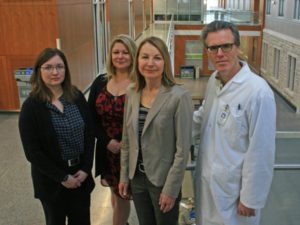$2.3 million CIHR grant funding research to improve quality and appropriateness of services in rural areas.
According to the Alzheimer Society of Canada, there are close to 564,000 Canadians living with dementia. This number is expected to increase by 66% over the next 15 years to 937,000. Rural areas are hit especially hard, according to Dr. Debra Morgan.
“Despite having a higher proportion of adults over the age of 65, rural areas have fewer primary health care, specialist, and support services available than cities. This leaves some people in rural communities living with undiagnosed dementia, and without an effective care plan to manage their disease as it progresses.”
Morgan is leading CCNA’s Team 20: Rural Stream, who are working to reverse this trend.
In partnership with primary health care providers and residents of rural communities, the team is developing strategies for dementia in rural Saskatchewan to improve the quality and appropriateness of services.
“We know that there are internationally accepted principles of dementia care for primary health care settings that are tied to better outcomes for people with dementia and their care partners. The challenge is one of adapting these principles for rural areas, as they come mostly from urban settings in other parts of Canada and other countries,” Morgan explains.

This has been an ongoing project for Morgan since 1999. A recent Foundation Grant award – $2.3 million from the Canadian Institutes of Health Research (CIHR) – will bolster the team’s efforts in examining interventions drawn from other urban settings and figuring out how to operationalize them in rural settings to improve primary health care, specialist, and support services.
For this, the team is using an adaptation model. Working directly with local health care providers, the joint team has come together to determine which components of existing interventions need to be adapted for the local context.
Specifically, the CIHR grant will support Morgan’s team in improving their existing Rural Dementia Action Research (RaDAR) primary health care Toolkit – making it adaptable, scalable, and sustainable across low-resource, diverse rural settings, at both the national and international level.
The team’s ReSPECT project (REmote Specialist-to-Primary care support enriched Care through Technology), led by Morgan’s CCNA colleague at the University of Saskatchewan, Dr. Megan O’Connell, aims to increase dementia-related knowledge of rural primary care providers, with a focus on remotely-delivered education that changes clinical practice. “Among other things, we will explore novel uses of technology to allow dementia specialists to remotely support primary care providers in diagnosing and caring for rural patients with dementia. The idea is to do this without having to refer typical cases for traditional face-to-face specialist consultation,” O’Connell explains.
Another piece the team is overseeing, led by Dr. Julie Kosteniuk, is the adaptation of decision support tools for health care providers in primary care, developed in Ontario by Dr. Dallas Seitz (co-lead of CCNA Team 11). These evidence-based tools – the Primary Care Dementia Assessment and Treatment Algorithm (PC-DATA) – take the form of visit flow sheets that health care providers consult and complete in the electronic medical record at the point of patient care. These records track patient information to support continuous, coordinated dementia care among members of the patient’s primary health care team.
Developing team-based care approaches to care is also a goal of the research. “The flow sheets can help to link various providers by allowing occupational therapists, nurse practitioners, physicians and home care nurses to fill out their sections regardless of where they see the patient,” Kosteniuk adds.
As Dr. Morgan sees it, “it’s a continuous adaptation in figuring out what works, where and why. This process will lead to the invention of different ways of doing things like team care, collaborative care, and providing patient support and education.”
To learn more about the work of CCNA’s Team 20: Rural Stream, click here.

